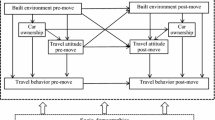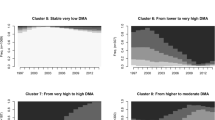Abstract
China’s transition from a planned economy to a market economy has resulted in many changes in its urban structure and society and provided an opportunity for a quasi-longitudinal case study on the relationship between the built environment and activity-travel behavior. This paper draws upon data from an activity diary survey conducted in Beijing in 2007. The survey sample comprised 652 residents living in Danwei (work unit), commodity housing, and affordable housing neighborhoods. On the basis of the three-dimensional geo-visualization analysis of the space-time path and statistical multivariate regression models of daily travel and leisure time, it was found that both residential spatial factors and socio-demographics influence residents’ daily behaviors. The findings show that Danwei residents have less daily travel time than those who live in commodity housing, but people living in affordable housing endure the longest travel time. Daily leisure time is associated more with individual attributes. We argue that although China’s transition is currently gradual, the Danwei system may continue to play significant roles in daily life, and it might provide a valuable model for neighborhood spatial planning.
Similar content being viewed by others
References
Ahmed N, Miller H J, 2007. Time-space transformations of geographic space for exploring, analyzing and visualizing transportation systems. Journal of Transport Geography, 15(1): 2–17. doi: 10.1016/j.jtrangeo.2005.11.004
Andrienko N, Andrienko G, 2007. Designing visual analytics methods for massive collections of movement data. Cartographica, 42(2): 117–138. doi: 10.3138/carto.42.2.117
Beijing Statistical Bureau, 2010. Beijing Statistical Yearbook 2010. Beijing: China Statistics Press. (in Chinese)
Bodea T D, Garrow L A, Meyer M D et al., 2009. Socio-demographic and built environment influences on the odds of being overweight or obese: The Atlanta experience. Transportation Research Part A, 43(4): 430–444. doi: 10.1016/j.tra.2008.11.009
Bray D, 2005. Social Space and Governance in Urban China: The Danwei System from Origins to Reform. Stanford, California: Stanford University Press.
Cao X, Handy S L, Mokhtarian P L, 2006. The influences of the built environment and residential self-selection on pedestrian behaviour: Evidence from Austin, TX. Transportation, 33(1): 1–20. doi: 10.1007/s11116-005-7027-2
Cao X, Mokhtarian P L, Handy S L, 2007. Do changes in neighborhood characteristics lead to changes in travel behavior? A structural equations modeling approach. Transportation, 34(5): 535–556. doi: 10.1007/s11116-007-9132-x
Cao X, Mokhtarian P, Handy S, 2009. The relationship between the built environment and nonwork travel: A case study of Northern California. Transportation Research Part A, 43(5): 548–559. doi:10.1016/j.tra.2009.02.001
Cervero R, 1996. Traditional neighborhoods and commuting in the San Francisco Bay Area. Transportation, 23(4): 373–394. doi: 10.1007/BF00223062
Chai Yanwei, 1996. Danwei-centered activity space in Chinese cities: A case study of Lanzhou. Geographical Research, 15(10): 30–38. (in Chinese)
Chai Y. 2012. New Danweism: A new conceptual framework for the future development in Urban China. In: International Conference on Spatial and Social Transformation in Urban China. Hong Kong, Dec. 13–14.
Chen J, Shaw S-L, Yu H et al., 2011. Exploratory data analysis of activity diary data: A space-time GIS approach. Journal of Transport Geography, 19(3): 394–404. doi: 10.1016/j.jtrangeo.2010.11.002
Dijst M, de Jong T, and van Eck R J, 2002. Opportunities for transport mode change: An exploration of a disaggregated approach. Environment and Planning B, 29(3): 413–430. doi: 10.1068/b12811
Ding D, Gebel K, 2012. Built environment, physical activity, and obesity: What have we learned from reviewing the literature? Health & Place, 18(1): 100–105. doi: 10.1016/j.healthplace.2011.08.021
Ewing R, Cervero R, 2001. Travel and the built environment: A synthesis. Journal of the Transportation Research Board, 34: 89–105. doi: 10.3141/1780-10
Fan Y, 2007. The Built Environment, Activity Space, and Time Allocation: An Activity-based Framework for Modelling the Land Use and Travel Connection. University of North Carolina at Chapel Hill, PhD Thesis.
Fan Y, Khattak A, 2009. Does urban form matter in solo and joint activity engagement? Landscape and Urban Planning, 92(3–4): 199–209. doi: 10.1016/j.landurbplan.2009.05.006
Gaubatz P, 1999. China’s urban transformation: Patterns and processes of morphological change in Beijing, Shanghai and Guangzhou. Urban Studies, 36(9): 1451–1521. doi: 10.1080/0042098992890
Hagerstrand T, 1970. What about people in regional science? Papers of the Regional Science Association, 24: 7–21. doi: 10.1007/BF01936872
Handy S, 1996. Methodologies for exploring the link between urban form and travel behavior. Transportation Research D, 1(2): 151–165. doi: 10.1016/S1361-9209(96)00010-7
Handy S, Boarnet M G, Ewing R et al., 2002. How the built environment affects physical activity: Views from urban planning. American Journal of Preventive Medicine, 23(2S): 64–73. doi: 10.1016/S0749-3797(02)00475-0
Huang Y, 2003. Renters’ housing behavior in transitional urban China. Housing Studies, 18(1): 103–126. doi: 10.1080/0267303032000076867
Huang Y, 2004. The road to homeownership: A longitudinal analysis of tenure transition in urban China (1949–1994). International Journal of Urban and Regional Research, 28(4): 774–795. doi: 10.1111/j.0309-1317.2004.00551.x
Janelle D G, Goodchild M F, 1988. Space-time diaries and travel characteristics for different levels of respondent aggregation. Environment and Planning A, 20(7): 891–906. doi: 10.1068/a200891
Kwan M P, 1999. Gender, the home-work link, and space-time patterns of nonemployment activities. Economic Geography, 75(4): 370–394. doi: 10.2307/144477
Kwan M P, 2000. Interactive geovisualization of activity-travel patterns using three-dimensional geographical information systems: a methodological exploration with a large data set. Transportation Research Part C, 8(1–6): 185–203. doi: 10.1016/S0968-090X(00)00017-6
Kwan M P, Lee J, 2004. Geovisualization of human activity patterns using 3-D GIS: A time-geographic approach. In: Goodchild M F et al.. (eds). Spatially Integrated Social Science. New York: Oxford University Press.
Lenntorp B, 1978. A time-geography simulation model of individual activity programmes. In: Carlstein T et al. (eds). Timing Space and Spacing Time. Vol 2: Human Activity and Time Geography. London: Enward Arnold, 162–180.
Li S, Huang Y, 2006. Urban housing in China: Market transition, housing mobility and neighborhood Change. Housing Studies, 21(5): 613–623. doi: 10.1080/02673030600807043
Ma L J C, 2002. Urban transformation in China, 1949–2000: A review and research agenda. Environment and Planning A, 34(9): 1545–1569. doi: 10.1068/a34192
Miller H J, 2005. A measurement theory for time geography. Geographical Analysis, 37(1): 17–45. doi: 10.1111/j.1538-4632.2005.00575.x
National Bureau of Statistics of China. 1999. China Statistical Yearbook 1999. Beijing: China Statistics Press. (in Chinese)
National Bureau of Statistics of China. 2009. China Statistical Yearbook 2009. Beijing: China Statistics Press. (in Chinese)
Pan H, Shen Q, Zhang M, 2009. Influence of urban form on travel behavior in four neighborhoods of Shanghai. Urban Studies, 46(2): 275–294. doi: 10.1177/0042098008099355
Schwanen T, Dijst M, 2003. Time windows in workers’ activity patterns: Empirical evidence from the Netherlands. Transportation, 30: 261–283. doi: 10.1023/A:1023905020890
Schwanen T, Dijst M, Dieleman F M, 2002. A microlevel analysis of residential context and travel time. Environment and Planning A, 34(3): 1487–1507. doi: 10.1068/a34159
Schwanen T, Mokhtarian P L, 2005. What affects commute mode choice: Neighborhood physical structure or preferences toward neighborhoods? Journal of Transport Geography, 13(1): 83–99. doi: 10.1016/j.jtrangeo.2004.11.001
Shaw S L, Yu H, 2009. A GIS-based time-geographic approach of studying individual activities and interactions in a hybrid physical-virtual space. Journal of Transport Geography, 17(2): 141–149. doi: 10.1016/j.jtrangeo.2008.11.012
State Council, 1994. State Council’s decision on deepening the reform of urban housing system. State Council Documentation, No. 43. (in Chinese)
State Council, 1998. A notification from the State Council on further deepening the reform of urban housing system and accelerating housing construction. State Council Documentation, No. 23. (in Chinese)
Van Eck R J, Burghouwt G, Dijst M, 2005. Lifestyles, spatial configurations and quality of life in daily travel: An explorative simulation study. Journal of Transport Geography, 13(2): 123–134. doi: 10.1016/j.jtrangeo.2004.04.013
Wang D, Chai Y, 2009. The jobs-housing relationship and commuting in Beijing, China: The legacy of Danwei. Journal of Transport Geography, 17(1): 30–38. doi: 10.1016/j.jtrangeo.2008.04.005
Wang D, Chai Y, Li F, 2011. Built environment diversities and activity-travel behavior variations in Beijing, China. Journal of Transport Geography, 19(6): 1173–1186. doi: 10.1016/j.jtrangeo.2011.03.008
Wang Y P, Murie A, 2000. Social and spatial implications of housing reform in China. International Journal of Urban and Regional Research, 24(2): 397–417. doi: 10.1111/1468-2427.00254
Zhao Ying, Chai Yanwei, Chen Jie et al., 2009. GIS-based analyzing method for spatial-temporal behavior data. Geography and Geo-Information Science, 25(5): 1–5. (in Chinese)
Author information
Authors and Affiliations
Corresponding author
Additional information
Foundation item: Under the auspices of National Natural Science Foundation of China (No. 40671058, 41071102), National ‘Twelfth Five-Year’ Plan for Science and Technology Support (No. 2012BAJ 05B04)
Rights and permissions
About this article
Cite this article
Zhao, Y., Chai, Y. Residents’ activity-travel behavior variation by communities in Beijing, China. Chin. Geogr. Sci. 23, 492–505 (2013). https://doi.org/10.1007/s11769-013-0616-7
Received:
Accepted:
Published:
Issue Date:
DOI: https://doi.org/10.1007/s11769-013-0616-7




